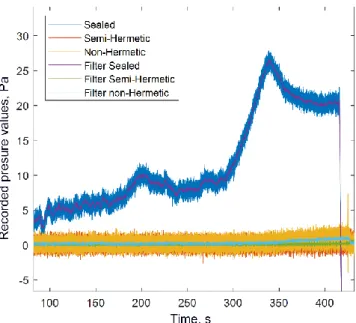44
thInternational Microelectronics and Packaging IMAPS Poland Conference,
18-21 April 2021, Poland
*Corresponding author: anna.nowak@ite.waw.pl. (Anna Nowak)
Investigating the application of flow and gauge pressure sensors in industrial vapour phase soldering
Mohamed Amine Alaya
1, Egon Rozs
1, Busek David
2, Attila Geczy
11Department of Electronics Technology, Budapest University of Technology and Economics, Budapest, Egry József u. 18. V1. 014. Hungary H-1111
2Department of Electrotechology, Czech Technical University in Prague, Faculty of Electrical Engineering, Prague, Czech Republic, Technická 1902/2, 166 27 Praha 6 - Dejvice-Praha 6,
Summary:
In this paper, the applicability of flow and gauge sensors are investigated in an industrial vapour phase soldering oven. The investigated oven represents a common application of the methodology in the industry on both prototyping and production levels. The sensor components are chosen according to previous findings, the results are compared with each other according to the detected phases of heat-level vapour phase soldering, the understanding of the received plots in fusion with the temperature readings and the state of the oven in terms of sealing quality of the workspace.
Key words: Vapour Phase Soldering, Applied Sensors, Pressure, Sensor, Gauge, Flow 1. MOTIVATION AND DESCRIPTION OF WORK
Vapour Phase Soldering technology is an interesting and promising reflow method applied in surface mount technology and in selected electronics assembling processes. The condensation based heat transfer and the preparation of the heat transfer medium is totally different than in the conventional convection-based reflow ovens so novel solutions are required to investigate the medium used for heat transfer [1]. We continue our previous investigations with the application of different pressure sensors in the vapour environment. It was previously presented, that the flow sensors are able to show saturated vapour dynamics, also it was later clarified, that with modern piezoelectric gauge pressure sensors, the validation of the process phases becomes even more precise [2]. Now the two methods are compared in a heat-level based vapour phase soldering oven. The experimental setup is presented in Figure 1, where an Asscon Quicky 450 heat level (HL-VPS) oven is retrofitted with an additional pair of hoses attached together with a K-Type thermocouple and immersed to the same level as where the printed circuit board assembly (PCBA) is lowered during heating.
Fig. 1. Experimental setup based on Q450 oven
44
thInternational Microelectronics and Packaging IMAPS Poland Conference,
18-21 April 2021, Poland
* Corresponding author: gattila@ett.bme.hu (Attila Géczy)
For the final results we apply K-type thermocouples with 2 mm solid conductor covered by insulation PFA layer allowing application in the operating range between -75 °C to +250 °C (ideal for lead-free reflow temperatures) with the precision of ±1 °C. We apply flow-type differential pressure sensors from Sensirion (SDP series – different sensors tpyes investigated for range and resulting signals) and gauge- type Honeywell HSD sensor with a heat resistant silicone hose with 2 mm inner diameter. We interfaced the sensors with National Instruments LabVIEW software for data acquisition.
2. RESULTS
Figure 2 presents a special case, where the gauge sensor is used to investigate the ramp up period of the HL-VPS profile – the peak here is representing the temperature saturation as well. The figure is focused on the difference between the sealed state and semi-sealed/non-sealed states of the oven. The pressure plots are distinguishably different at different states. The final paper will present results of the flow sensor in comparison with the gauge results, also the matching parts of the HL-VPS phases in comparison with the temperature recordings.
Fig. 2. Ramp-up period of a HL-VPS process recorded with gauge pressure sensors with different oven sealing states
Acknowledgment
The research was partially supported by the National Research, Development and Innovation Of-fice – NKFIH, FK 132186. The research reported in this paper and carried out at the BME has been partially supported by the NRDI Fund based on the charter of bolster issued by the NRDI Office under the auspices of the Ministry for Innovation and Technology.
3. REFERENCES
[1] Livovsky, L., Pietrikova, A., Measurement and regulation of saturated vapour height level in VPS chamber, 2019. Solder Surf Mt Technol, Vol. 31, No. 3, pp. 157-162.
[2] Alaya, M.A., Geczy, A., Illes, B., Harsányi, G. and Bušek, D. (2019), "Advances in pressure sensing for vapour phase soldering process monitoring", Soldering & Surface Mount Technology, Vol. 31 No. 3, pp. 169-175.
https://doi.org/10.1108/SSMT-10-2018-0038

